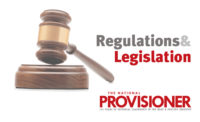The Food Safety and Inspection Service (FSIS) held a public meeting, “Preventing Undeclared Allergens: A Strategic Approach to Reducing Recalls,” on March 16 because allergen recalls make up a majority of recalls. This meeting discussed polices on allergen control and best practices for prevention and controlling allergen cross-contact, including during sanitation and labeling.
Based on my representing the food industry and information from colleagues, I have compiled a list of items to consider regarding control of allergens during production. Had some of these points been considered, many allergen recalls could have been prevented.
Best practices in allergen control
An effective allergen control plan begins with an establishment’s HACCP plan. First, allergens must be identified. This begins at receiving ingredients, ensuring ingredients are cross-referenced throughout production and proper separation within the company. Next, the establishment must control allergen cross-contact that may affect equipment, processing, production schedules and sanitation. Finally, all allergens must be declared properly on packaging and labeling, including during storage and any rework process within the establishment.
When performing a hazard analysis, an establishment should consider:
• Do suppliers have adequate allergen controls in place if using multiple allergenic ingredients?
• Are there procedures ensuring allergen separation throughout production? Is storage controlled as well as the use of allergens from receipt through formulation, batching and final packaging?
• Are there procedures ensuring all allergen cross-contact equipment can be cleaned effectively? Sanitary equipment designs allowing cleaning to control pathogens also allow effective cleaning between allergens.
• Are there procedures to ensure labels and packaging materials are printed correctly and controlled at use?
• Are employees trained on why allergen control is important and the procedures to prevent allergen cross-contact or product mislabeling? If employees do not know someone who has a food allergy, they do not have the same level of awareness of the severe consequences that can occur.
• How is the effectiveness of the allergen control procedures verified? Are test kits used to determine whether any allergen residue remains after cleaning? Are periodic checks done to ensure employees are following procedures?
An establishment should determine whether adequate procedures are in place to ensure labeling and packaging are correct.
• Are all incoming labels reviewed to ensure they were printed correctly? (Helpful hint: Make a transparency of the correct label. If it fits, it is correct. If it does not fit, it is wrong. This works even if the language cannot be read.
• Is obsolete labeling or old batch sheets from discontinued formulations removed so they cannot be used accidentally? (Helpful hint: Be sure batch sheets are printed for each production day and employees do not keep copies in lockers or elsewhere to avoid “the long walk” to pick up a new sheet each day.)
• Are labels checked on all incoming ingredients to ensure no changes were made by the supplier? (Helpful hint: A transparency may be used for these as well. When formulating new products, be sure to use the actual ingredient label and not the specification sheet, which may not be up-to-date.)
• What crosscheck procedures are in place for label changeovers? (Helpful hint: Consider not bringing in new labels until the previous labels have been removed from the area.)
• If possible, have bar scanners to read label codes. (Helpful hint: Ensure training on proper programming is done, but have additional checks to ensure codes are entered correctly.)
• When personnel must check a label, require the label information be read aloud. If someone is just looking at a label, chances are very high they will “see” the correct label. Reading aloud is a much better way to prevent using the wrong label. My colleague told me about once having a production line run an entire shift with the wrong label and five employees — including a quality assurance technician and a supervisor — swore the label was correct, and all of the net weight, QA evaluation sheets and production sheets indicated it was correct.
Remember most allergens cannot be seen in a product. The only way someone who is allergic knows what is in a product is if the food industry tells him on the label. It is up to manufacturers to ensure this occurs. NP







Report Abusive Comment